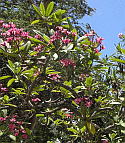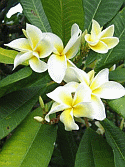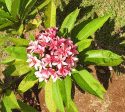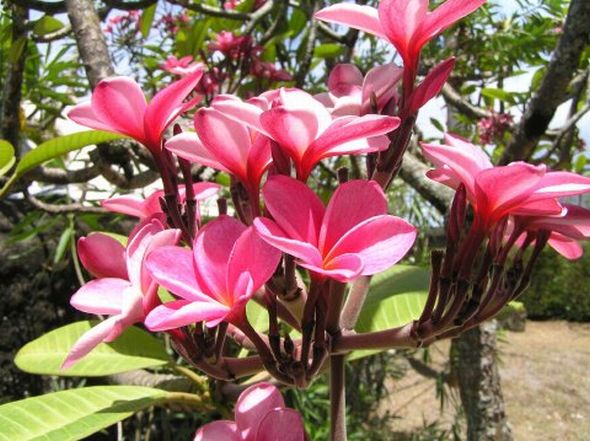
Roseau, Commonwealth of Dominica, West Indies

 |
Dominica Botanic Gardens Roseau, Commonwealth of Dominica, West Indies |
 |
| © Dominica Academy of Arts and Sciences, Dec. 2004 | Home Page | Comments & Suggestions |Site Coordinator | Gardens Curator |
| Selected Trees and Shrubs: Plumeria rubra var. acuminata, Common name: Frangipani, Temple Tree |






|
 Clayton Shillingford Plant Family: Belongs to the Apocynaceae or Periwinkle family, which includes several other Frangipani species and numerous varieties; family also includes the large Ditta Bark tree (Alstonia scholaris), Allamanda (Allamanda cathartica) and Oleander (Nerium oleander) Description: Low, spreading, deciduous, semi-succulent tree, sap milky, up to 9 m tall (30 ft), with broad, wide-headed canopy, often as wide as tree is tall, exceptionally attractive when flowering; stem contains a white, poisonous milky sap; branches swollen, pale green, semi-succulent, are weak and easily broken; has large oblong leathery leaves, usually glossy green, 20-30 cm long (8-12 in) and 8 cm wide (3 in), arranged alternately and clustered at branch ends; almost or quite bare of leaves in dry season; tends to flower continuously in Caribbean, bearing large bunches of beautiful white, highly fragrant, waxy flowers, about 5-10 cm across (2-4 in) with five petals arranged in a tubular funnel shape; flowers occasionally followed by a few pods; the numerous species and varieties of Frangipani are characterized by a range of visually striking, vibrant flower colors – whites, yellows, pinks, dark reds and every shade in-between; to see some exceptionally beautiful Hawaiian examples, click here and scroll down. Natural Habitat: Hot, dry to moderate rainfall areas, up to 600 m elevation (2000 ft); grows best in full sun and well drained soil; stands sea breeze well; easily and usually propagated by cuttings, less often by seed, which remain viable for about three months but seedlings take three years or more to flower. Origin and Distribution: Native to Tropical America; but now seen in tropical and semi-tropical countries around the world; is popular in dry to moderate rainfall areas throughout the Caribbean; in Dominica, a few specimens are also seen in the wetter uplands. Uses: Primarily an outdoor ornamental, but also as an indoor potted plant; flowers used to make the popular and colorful Hawaiian leis.
Indigenous Legends: In Asia, often planted near Buddhist temples, hence also called Temple or Pagoda tree; flowers treasured by the Polynesian Islanders for their durability, fragrances and variety of colors.
References: |
| © Dominica Academy of Arts and Sciences, Dec. 2004 | Home Page | Comments & Suggestions |Site Coordinator | Gardens Curator |